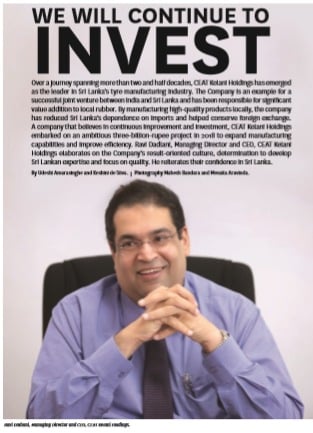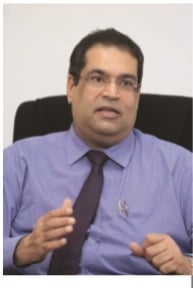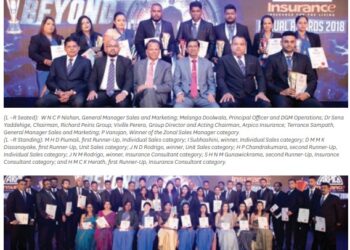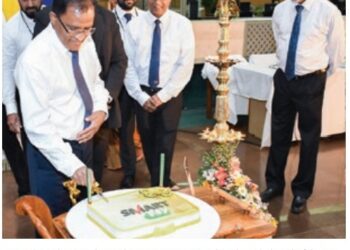
CEAT has been in the country for more than 25 years. can you elaborate on the journey of cEAT Kelani Holdings?
The CEAT brand has been in Sri Lanka for longer, but the CEAT-AMW and Kelani tripartite venture was formed in 1998. AMW exited the business in 2010 and since then it has been a 50:50 joint venture between CEAT India and Kelani Tyres. Since the commencement of the CEAT Kelani partnership in 1998, a number of breakthrough initiatives have taken place in terms of technology infusion, product upgrading and brand equity building. We refreshed our logo and introduced a new identity in 2010. We created CEAT as a new avatar in terms of how the market perceived the brand. This was also an opportune time because the conflict in Sri Lanka had just ended and the country had entered a period of peace. We decided that we would strengthen all our product segments. We were predominantly a heavy vehicle tyre company, dominating the commercial tyre sector. The perception that people had for CEAT was that it is a truck, bus, or tractor tyre. In 2010, we opted for a logo with a softer dynamic, where we dropped the original “Rhino” as a symbol of our brand. We felt that the Rhino was a rough and tough symbol, which we no longer wanted to associate with the brand. Thus, we moved to a softer, more consumer-centric look and feel for the brand. That preceded the next round of expansion. We ventured into the consumer segment with radial tyres for cars and vans in 2006. By 2010, we focused on an endorsement to the category and wanted the consumer to look at us differently; as a consumer-centric product and company. We started expanding into the car and van categories, and we took the next step by 2013/2014, when we started manufacturing motorcycle tyres. We are now a full range company that produces locally to international standards for the domestic and export markets. Between 2010 and 2017, we grew by 50 percent in capacity term and have increased our local volumes by almost two-fold in the past ten years. This was due to the peace dividend and the fact that people are travelling more and our continuous expansions. In January 2018, we announced another significant investment of three billion rupees. We made this investment because we had still not ventured into market segments such as TBR (Truck, Bus, Radials), which we launched in June this year.
We Aim To Build Both Processes And Consistency In Our Manufacturing. We Have Already Spent 1.5 Billion Rupees And Have Another 1.5 Billion Rupees To Go. Our Commitments Will Be Realized Within The Next Eight Months. By March 31, 2020, We Aim To Complete The Three Billion Rupee Expansion.
Therefore, 2018-19 has been a year of investment, testing, understanding how the product performs in Sri Lanka, and understanding the market needs, as a result of which we have commissioned a TBR plant with an 800-million-rupee investment. There is a strong perception that what is manufactured in Sri Lanka is not as good as what is manufactured internationally. Given this mindset, we benchmark our product in terms of quality, and product offering to ensure we meet international standards. Of the threebillion-rupee commitment embarked on in January 2018, nearly 700 million rupees is on product, quality, and equipment improvement. We aim to build both processes and consistency in our manufacturing. We have already spent 1.5 billion rupees and have another 1.5 billion rupees to go. Our commitments will be realized within the next eight months. By March 31, 2020, we aim to complete the three billion rupee expansion.
CEAT is the largest domestic manufacturer of cross-ply and radial tyres in Sri lanka. can you elaborate on this?
Our product range includes tyres for agricultural vehicles, trucks, buses, passenger cars, utility vehicles, SUVs, motorcycles and three-wheelers. We now manufacture TBRs in Sri Lanka as well. In terms of market share, we have about 50 percent of the total tyre market in Sri Lanka. We also substantially substitute imports, thereby saving foreign currency for the country. Leveraging on an FTA with India, we export tyres to our sister company in India. We export about 30 percent of our products to countries in the Middle East, North Africa and South East Asia. Within the Sri Lankan truck and bus category we have a 70-75 percent market share. In radials we compete with about 70 to 80 international brands, but we command a 32 percent market share. Although we entered the motorcycle segment only five years ago, and despite competing with an entrenched local competitor in Sri Lanka, we have captured about 33 percent of the market.
CEAT Kelani Holdings has been expanding continuously, can you speak about the production facilities?
We have two factories in Kelaniya and in Kalutara. Kalutara is a BOI approved factory, and the minimum requirement for this facility is that we export 50 percent of the production. We currently export 52-53 percent of the output from Kalutara.

Our Kelaniya plant has for management purposes been separated into three factories, the truck and bus tyre plant that caters to the local market, the radial plant that predominantly supplies the local market with 90 percent of its output and the scooter and motorcycle tyre plant, which is also mostly focused on the local market. Over the past ten years we have brought in a lot of equipment, and have improved the processes. We have introduced a completely different outlook in terms of how we want to produce tyres. In addition to increasing productivity and enhancing our knowledge base, we are reengineering the production line as well to enable economies of scale
We Are One Of The Most Successful Sri Lanka-India Joint Ventures. We Enjoy The Best Of Both Worlds.
What about the sourcing of raw materials?
In our total product content, natural rubber accounts for between 26 to 30 percent. Natural rubber is procured 100 percent locally. Only on rare occasions do we import rubber if there is an issue in availability, and we import to ensure our export market commitments are serviced and sustained. We are the largest procurers of natural rubber in Sri Lanka among the pneumatic manufacturers. Other large procurers are companies that are solid tyre manufacturing companies. All other raw materials, almost 70 – 74 percent depending on different product categories, are imported. Carbon Black, Beed Wire, Fabric, and Synthetic rubber are some of the materials that are from overseas because they are not available in Sri Lanka. We also have an advantage because our procurement of raw materials, other than natural rubber, is linked to CEAT India. We leverage the benefit that we have with their suppliers, who are all registered and approved suppliers. The components that we use for local supply are the same as those used in India. We focus on the quality, specs and engineering of the product. We do not change the composition.
could you emphasize on the strength of being a joint venture?
We are one of the most successful Sri LankaIndia joint ventures. We enjoy the best of both worlds. We have the technology, R&D support, and strength of the tyre industry from CEAT India. The expertise of managing large markets and investments, focus and equipment are also strengths of CEAT India. The advantage from the local perspective is in terms of the diverse knowledge of the Sri Lankan market, local expertise, and managing policy and local industry. Having two diverse ownerships, which are willing to meet on the same platform for the benefit of taking the company forward is the reason for success.
What more can be done in the tyre and manufacturing industries?
We have a long way to go in the tyre industry. We want CEAT to be accepted as one of the best brands, products, and service providers in Sri Lanka for the automotive segment. We already have a considerable affinity and brand record amongst customers. When you say CEAT, they know what we offer. We are also one of the only companies in the Sri Lankan tyre industry that provides an unconditional warranty on our products. We offer a one to one replacement up to 30 percent wear on truck tyres, and up to 50 percent wear on van or car tyres. This is an unparalleled warranty with which customers are completely satisfied. We would like to improve the quality of our products further to reach even higher international standards beyond what the consumer wants. We are in the process of replacing some equipment for this purpose, but being the only pneumatic tyre manufacturer in Sri Lanka, we find it difficult to find skilled people. I believe there is a lot the industry can do. One of the biggest challenges for us is consistency in policy. We find that while successive Governments have been supporting the sector, policy inconsistency is an area of concern. For example, with the three-billion-rupee investment we made in January 2018, once we order the equipment, it takes eight to 16 months for the machinery to arrive. After that, by the time trials and testing processes are completed, it is another three to six months. It takes 24 months to launch the product. Within that period, there will be two National Budgets. It does not always happen, but at times, our investment interests are questioned. We saw local market consumption dropping tremendously in the last 18 to 24 months. We would want to expand capacity and improve product quality by investing, but we have to factor in the market decline as well. Inconsistent policies contribute to such situations. The industry and manufacturers need to become involved and drive the industry forward according to a three to five-year plan. We also find it very difficult to find skilled staff. One issue may be the cost structure due to the costs of having people from villagers settling down in Colombo and having to pay for room and board. Trained people migrate to other industries that are coming up, saying that they are unable to live in Colombo. Our productivity is currently 11kg per man-hour, while India is at about 21kg per man-hour, and China is at 29kg per man-hour. That is the number of kilograms of tyres manufactured per staff member per hour. We are at the lowest end of productivity. There is also the challenge of improving productivity through modernization, up-skilling and retention of workers. We have fantastic relationships with our staff, and there is a mutual understanding
I Believe There Is A Lot The Industry Can Do. One Of The Biggest Challenges For Us Is Consistency In Policy. We Find That While Successive Governments Have Been Supporting The Sector, Policy Inconsistency Is An Area Of Concern.
We have a tremendous workforce, both at the managerial level and workers level. However, we still need to keep investing in training. Annual rubber production used to be 150 million kilograms in Sri Lanka eight years ago but is down to 75 million kilograms today. Therefore, a key issue we see in terms of production is that when commodity prices fluctuate, we find it difficult to source natural rubber from Sri Lanka. The private sector, industry, and Government must work together and ensure the growth of the rubber industry and harness the benefit of rubber plantations. In rubber, the first harvest comes in six years. Therefore, if you do not invest today, in six years, from where will we acquire rubber? We need to work towards the sustainability of the rubber industry.
How does cEAT stand out from the rest?
Something noteworthy about the Sri Lankan market is the strength of our brand. Any new manufacturer willing to come into Sri Lanka needs at least 50 to 60 percent of its products available for exports. Therefore, a certain amount of international linkage would be required. It has taken a long time for us to build an export market of 35 percent. It is also somewhat paradoxical; I say that our productivity is as low as 11 percent, but we are also exporting 35 percent of our production. Even with productivity being low, we can export because we are offering something that cannot be obtained from other international competitors. We offer product quality. We do not compromise on quality. Whether you import the tyre from CEAT India or CEAT Kelani Holdings, we guarantee the same product quality. Given that we are a smaller unit in
Sri Lanka, we can manufacture smaller quantities to fit into one container. But China might only be able to send one size in five containers; this is the difference. We are a boutique manufacturing unit when compared with China and India, and that has been an advantage for us. However, you cannot take away the product coming from those markets. We are protected as a local industry by the Government and have benefited because there are specific import duties in place to protect the local industry. That is a compliment to the Government because we have close to 1,200 employed with us and we add value to local rubber. Rather than exporting raw rubber, we do value-added exports. However, the competition for CEAT in Sri Lanka is high because all brands are represented in imports. Importation in Sri Lanka is a straightforward and swift process. What happens is that international brands that cater to the world’s markets, upgrade their products on a daily, weekly, or monthly basis. The best global brands, sizes, and patterns are available in Sri Lanka. Every international tyre brand is available in Sri Lanka because we are a very import-dependent country. Consumer habits are important. Our mindset is that everything imported is good and things made in Sri Lanka are not good. We do have to improve in some areas, but we have already embarked on that journey. I can tell you that in terms of consumer sentiment on our brand, its acceptance and value for money proposition, consumers have accepted CEAT as a reliable product. That is something that we have built over the past eight to ten years.
You are the first Sri lankan CEO of the company. can you talk about the significance of this?
I have been with CEAT Kelani Holdings for 12 years. I started as GM Sales and Marketing and progressed to Vice President. I am a Sri Lankan, but I also have Indian roots as my mother is from Mumbai. But I was born and bred in Sri Lanka. CEAT has always believed in using the best expertise available. At the time of establishment of the joint venture there was no pneumatic tyre manufacturing knowledge in Sri Lanka, and we needed Indian expertise. We needed a certain amount of time to establish local capabilities. CEAT is one of the largest manufacturers in India, and even today, the GM heading the manufacturing unit in Sri Lanka is from India. An Indian national also heads the technology unit as well as accounts and finance. We have a strong expat team in support. I started my career at The Maharaja Organization as a Management Trainee. I worked for S-Lon and then for Pepsi. I was one among key personal instrumental in setting up the Pepsi distribution network in Sri Lanka. After that, I worked for a venture capital company. Then I set up a company to sell and manufacture water tanks. My experiences have been diverse and except for the period in the venture capital company; my career has been in manufacturing. However, my strengths have always been in sales, marketing and operations.
We Have Generated Growth For Sri Lanka. In Terms Of CEAT Import Substitution As Well As Export Of Surplus Capacity That Brings In Foreign Currency. We Are Very Confident In Sri Lanka, And We Will Not Stop Investing.
I am also a workaholic. Of course, I enjoy what I do and love the challenge. I have had the privilege of working for two number one companies in Sri Lanka – S-Lon being the number one PVC brand and CEAT the leading tyre brand. I enjoyed being a part of that growth, and I think I also contributed in some way to that team that helped grow these businesses. I do not believe you can get that satisfaction from anywhere else. The significance of me being a Sri Lankan is that I have wider knowledge of the local market because I have worked in Sri Lanka for 30 years. One of the mandates given to me by the local and foreign owners was that we need more Sri Lankan talent even for positions currently held by expats. We would like more Sri Lankan involvement. However, we also want the same firmness, professionalism, and drive that our Indian expats bring to the table. We have a very performance-driven culture. Everyone in the system knows his or her responsibilities. At the end of the year, they can also work out their bonuses and income based on how they have performed. My belief is that this position should be continuously held by a Sri Lankan, and that is the long term thought process of the owners as well.
CEAT continues to expand, does this reflect confidence in the country?
Absolutely, in good times or bad times, CEAT has gone ahead with its plans. After 2009, when the country obtained peace, we had three-years of massive growth with a 20 percent CAGR type growth. Suddenly we had a dip in growth, and it was in this period that we decided to expand in motorcycle and radial capacity. Our radial segment is in its fourth phase of expansion. It has been a ‘never stop moving’ kind of approach for us. Our shareholders invest because of the confidence that we have both in the country and industry and our ability to drive growth and deliver significant benefits to the country through value addition. I believe that because we developed and invested in the local market, this combination has ensured we are also stable where the country is concerned. We have generated growth for Sri Lanka. In terms of CEAT import substitution as well as export of surplus capacity that brings in foreign currency. We are very confident in Sri Lanka, and we will not stop investing.





